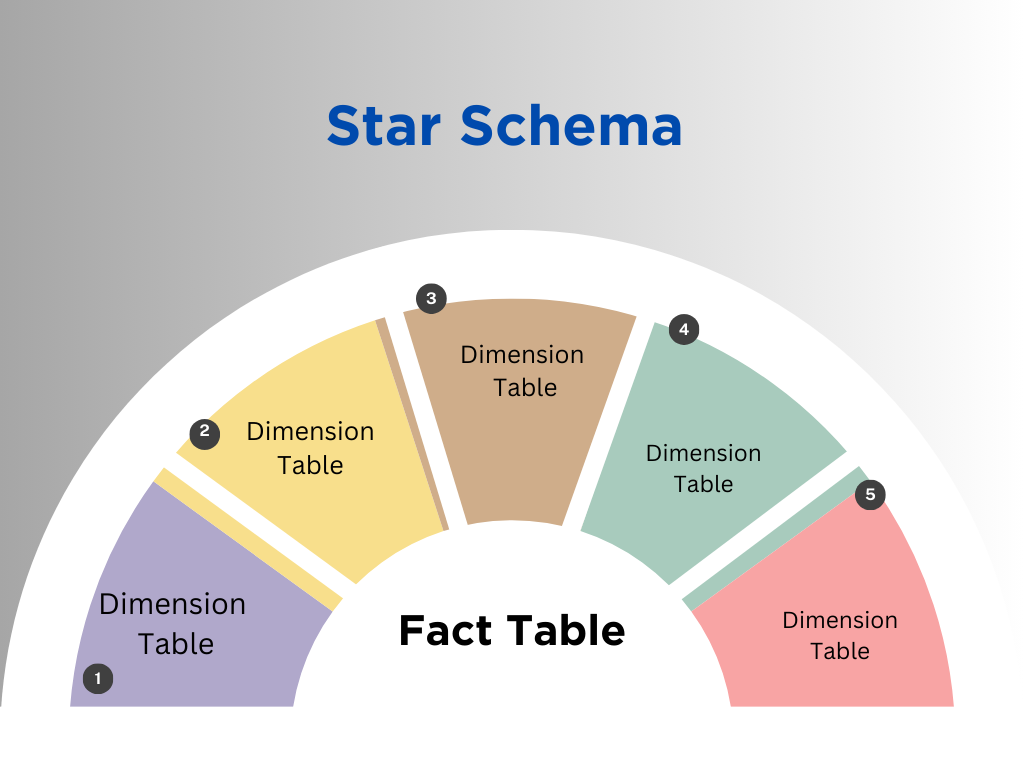Snowflake Schema vs Star Schema- Key Aspects
Star Schema
The star schema stands as a prominent multidimensional model, meticulously designed to enhance the efficiency of querying and reporting. This schema encapsulates the synergy between fact tables and dimension tables, paving the way for a streamlined and intuitive approach to data analysis.
Snowflake Schema
The Snowflake Schema introduces a layer of granularity by including sub-dimension tables. These tables delve into finer details, capturing subtle nuances and relationships within the data. The result is a meticulously structured hierarchy that provides a comprehensive and detailed representation of the underlying information.

Snowflake Schema VS Star Schema
| S.no | Feature | Star Schema | Snowflake Schema |
|---|---|---|---|
| 1. | Tables Composition | Fact tables and dimension tables are contained. | Fact tables, dimension tables, and sub-dimensions are contained. |
| 2. | Modeling Approach | Top-down model | Bottom-up model |
| 3. | Space Utilization | Uses more space | Uses less space |
| 4. | Query Execution Time | Takes less time for query execution | Takes more time than star schema for query execution |
| 5. | Normalization Usage | Normalization is not used | Utilizes both normalization and denormalization |
| 6. | Design Complexity | Design is very simple | Design is complex |
| 7. | Query Complexity | Low query complexity | Higher query complexity than star schema |
| 8. | Understanding Complexity | Understanding is very simple | Understanding is difficult |
| 9. | Foreign Keys | Less number of foreign keys | More number of foreign keys |
| 10. | Data Redundancy | High data redundancy | Low data redundancy |
Star Schema
- Considered one of the most straightforward designs in data warehousing.
- Shares a structural resemblance with the star schema.
- Effective for querying expansive datasets.
- Comprising a fact table encircled by a dimension table, the star schema follows a top-down approach.
- Characterized by a denormalized data structure, leading to efficient query performance.
- Occupies a larger storage footprint.
- Well-suited schema for data marts featuring uncomplicated relationships.
Snowflake Schema
- The snowflake schema is an expanded version of the star schema, incorporating a subdimensions table in addition to a fact table and a dimension table.
- It mirrors the configuration of a snowflake.
- Well-suited for querying compact datasets.
- Comprising a fact table encircled by a dimension table and a sub dimension table, the snowflake schema adheres to a bottom-to-top approach.
- Characterized by a normalized data structure.
- Occupies a smaller storage footprint.
- Ideal schema for data warehousing purposes.

Advantages and Disadvantages Of Star Schema
Advantages:
- Simplicity and Intuitiveness:
Advantage: The Star Schema is renowned for its simplicity. Its straightforward design, featuring a central fact table surrounded by dimension tables, makes it easy to understand and navigate for both developers and end-users. This simplicity accelerates query development and enhances user adoption.
- Optimized Query Performance:
Advantage: With fewer foreign-key joins and a denormalized structure, the Star Schema excels in query performance. Queries are executed more efficiently, leading to faster data retrieval. This optimization is particularly advantageous in scenarios where quick access to information is crucial.
- Flexibility and Adaptability:
Advantage: The Star Schema’s modularity allows for easy integration of new dimensions or modifications to existing ones. This flexibility ensures that the schema can evolve alongside changing business requirements, making it suitable for dynamic and growing organizations.
- Enhanced Data Aggregation:
Advantage: Aggregating data is seamless in the Star Schema. The centralized fact table facilitates efficient summarization and calculation of key metrics, providing a high-level overview of business performance.
- Scalability:
Advantage: The Star Schema’s design supports scalability, enabling organizations to expand their data warehouses without compromising performance. This scalability is crucial as data volumes grow over time.
- Improved Maintenance:
Advantage: Maintenance tasks such as indexing and optimization are more straightforward in the Star Schema. Its denormalized structure simplifies the implementation of indexing strategies, contributing to overall database health.
Disadvantages:
- High Data Redundancy:
Disadvantage: The denormalized nature of the Star Schema can lead to high data redundancy. This redundancy, while beneficial for performance, may result in larger storage requirements.
- Limited Support for Complex Relationships:
Disadvantage: In scenarios where data relationships are highly complex and involve nested hierarchies, the Star Schema may fall short. Its simplistic design may not adequately capture intricate relationships.
- Challenges with Changing Business Requirements:
Disadvantage: While flexible to some extent, the Star Schema may face challenges when dealing with rapidly changing business requirements. Modifying existing structures or introducing new dimensions can be more involved compared to other schemas.

Advantages and Disadvantages Of Snowflake Schema
Advantages:
- Normalized Structure:
Advantage: The Snowflake Schema’s commitment to normalization minimizes data redundancy. Breaking down dimensions into sub-dimensions ensures efficient storage utilization and data integrity.
- Flexibility in Hierarchy:
Advantage: The inclusion of sub-dimension tables provides flexibility in representing hierarchical relationships. This is especially advantageous in scenarios where a more granular level of detail is required.
- Scalability:
Advantage: Similar to the Star Schema, the Snowflake Schema supports scalability. Its modular design allows for the seamless addition of new sub-dimensions or modifications to existing ones.
- Enhanced Data Integrity:
Advantage: The normalized structure contributes to enhanced data integrity. By adhering to standardized data structures, the Snowflake Schema reduces the risk of anomalies and inconsistencies.
- Support for Complex Business Requirements:
Advantage: The Snowflake Schema excels in environments with intricate relationships and dependencies. Its ability to capture nuanced data connections makes it well-suited for industries with complex business requirements.
Disadvantages:
- Increased Query Complexity:
Disadvantage: Navigating through multiple levels of sub-dimensions may contribute to increased query complexity. Queries involving numerous joins can impact query execution time, especially in scenarios with deep hierarchies.
- Design Complexity:
Disadvantage: The inclusion of sub-dimensions adds a layer of complexity to the schema design. Database administrators and developers need to carefully structure the schema to ensure optimal performance while catering to the intricacies of the dataset.
- Understanding Challenges:
Disadvantage: Due to its intricate design, the Snowflake Schema may pose challenges in understanding for those unfamiliar with its branching structure. Training and documentation become crucial to ensuring efficient utilization.
Frequently asked questions about
The Snowflake schema proves to be a suitable choice when users need to explore data in a detailed manner. Its inherent structure facilitates seamless navigation through data over various time periods, allowing for effective comparisons between different data states. This schema is particularly advantageous for scenarios requiring a clear representation of date dimensions, such as organizing data hierarchically from decades down to specific times of the day.
Decades -> Years -> Quarters -> Months -> Weeks -> Days -> Time.
the Snowflake schema becomes essential. It efficiently organizes data hierarchies, accommodating global, regional, divisional, and local organizational levels. This makes it a valuable choice for applications demanding in-depth exploration of product data with multiple drill-down options.
The snowflake schema offers flexibility and normalization, making it suitable for handling intricate and dynamic dimensions and hierarchies.
In the star schema, denormalization and redundancy are employed to enhance read performance, albeit at the cost of potentially wider dimension tables, resulting in increased storage requirements.
Star Schema: Simplifies complexity, accelerates query execution, and facilitates easy setup.
Snowflake Schema: Optimizes storage space, simplifies maintenance, and minimizes susceptibility to data integrity issues.
Understanding Star and Snowflake Schema
Both star and snowflake schema designs involve segregating facts and dimensions into distinct tables.
The star schema Is a streamlined data structure with a singular join between the fact table and its dimensional tables, resulting in faster query performance and simplified data analysis. It is well-suited for managing substantial data volumes and is more user-friendly.
The widespread acceptance of the star schema as a best practice is attributed to its simplicity. It is easier for business users to comprehend compared to traditional source system models.
- Best ETL Tool for Snowflake Schema
The snowflake schema is compatible with various ETL tools, including Talend, Informatica, SSIS, and Talend Cloud. The choice of the tool depends on specific demands and requirements.
OLAP or OLTP: Star Schema’s Role
Star schema finds extensive application in OLAP systems for creating efficient OLAP cubes. Additionally, most major OLAP systems offer a ROLAP mode utilizing the star schema as input without cube structure creation.
Star Schema is often faster for complex queries due to its denormalized structure, which reduces the number of joins compared to the more normalized Snowflake Schema.
Snowflake Schema, with its normalized structure, is less prone to data integrity issues, providing a more robust framework for maintaining data consistency.
Star Schema is often preferred for real-time data processing due to its simplified structure and faster query performance, making it more responsive to dynamic data updates.
Snowflake Schema is frequently chosen in industries with intricate and evolving data hierarchies, such as healthcare and finance, where normalized structures can better accommodate changing data relationships.
Star Schema may require more adjustments when dealing with changes in data dimensions, while Snowflake Schema, with its normalized approach, can be more flexible in adapting to evolving data structures.
Star Schema, with its denormalized structure, may lead to increased storage requirements as the dataset scales. Snowflake Schema, being more normalized, is often more scalable in terms of storage efficiency.
Star Schema is generally considered more user-friendly for end-users due to its simplicity and straightforward relationships between the fact table and dimensions.
Star Schema’s simplicity often makes it more conducive to BI tool integration and dashboard development, providing a more intuitive experience for users.
Yes, some hybrid approaches exist, incorporating elements of both Snowflake and Star Schemas to balance performance and normalization based on specific requirements.
Factors such as data complexity, query performance needs, storage constraints, and the nature of data relationships should be carefully evaluated to determine the most suitable schema.
